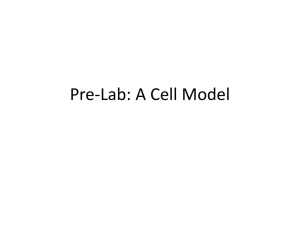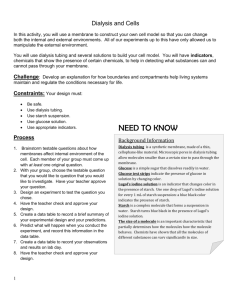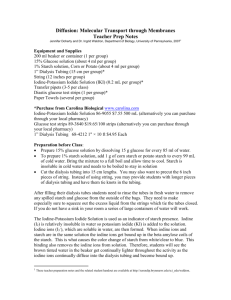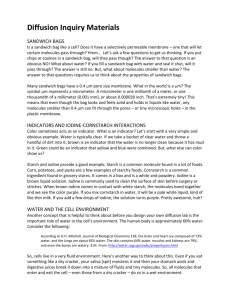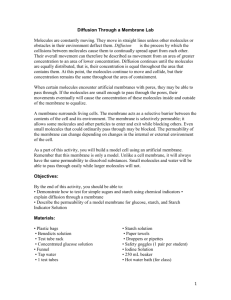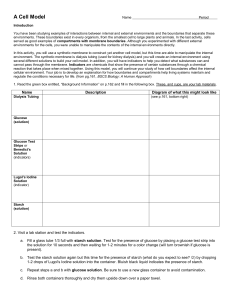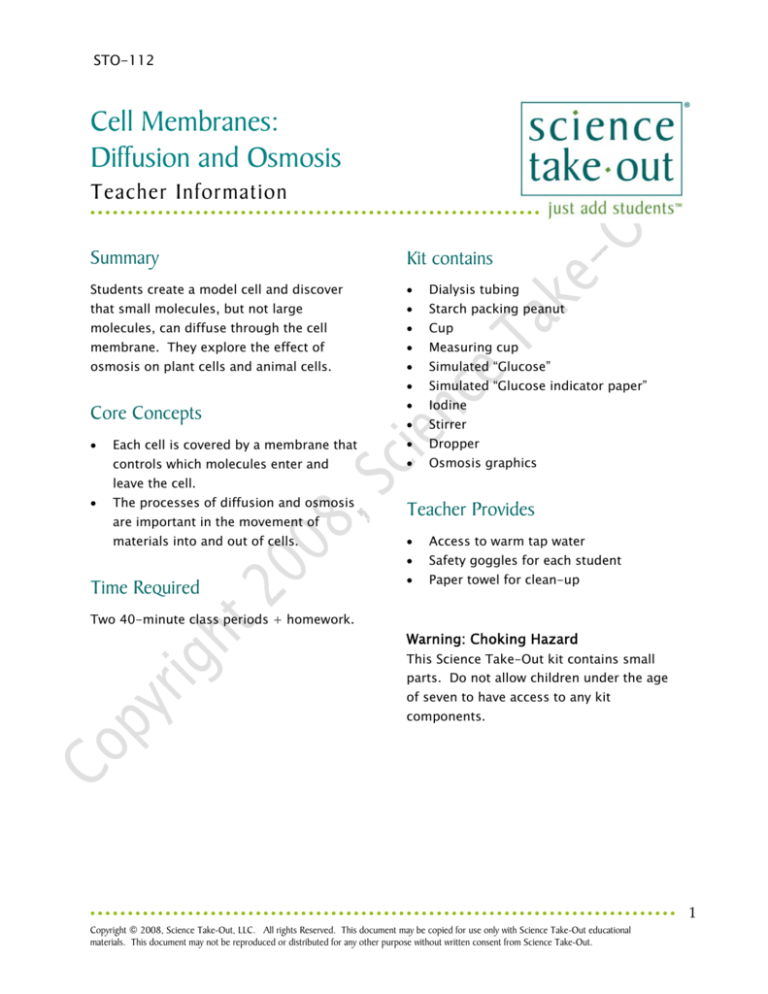
STO-112
Cell Membranes:
Diffusion and Osmosis
Teacher Information
Summary
Kit contains
Students create a model cell and discover
•
that small molecules, but not large
molecules, can diffuse through the cell
membrane. They explore the effect of
osmosis on plant cells and animal cells.
Core Concepts
•
Each cell is covered by a membrane that
controls which molecules enter and
•
•
•
Dialysis tubing
Starch packing peanut
Cup
Measuring cup
•
Simulated “Glucose”
•
Simulated “Glucose indicator paper”
•
•
•
•
Iodine
Stirrer
Dropper
Osmosis graphics
leave the cell.
•
The processes of diffusion and osmosis
are important in the movement of
materials into and out of cells.
Teacher Provides
•
•
Time Required
Two 40-minute class periods + homework.
•
Access to warm tap water
Safety goggles for each student
Paper towel for clean-up
Warning: Choking Hazard
This Science Take-Out kit contains small
parts. Do not allow children under the age
of seven to have access to any kit
components.
1
Copyright © 2008, Science Take-Out, LLC. All
Allrights
rightsreserved.
Reserved. This document may be copied for use only with Science Take-Out educational
www.sciencetakeout.com
materials.
This document may not be reproduced or distributed for any other purpose without written consent from Science Take-Out.
Reusing Cell Membranes: Diffusion and Osmosis kits
Teachers will need to instruct students on how to handle clean-up and return of the re-usable
kit materials. For example, teachers might provide the following information for students:
Rinse with water and dry
Discard
•
Used dialysis membrane
and contents
•
Return to kit
with paper towel
•
•
Large Cup
•
•
glucose tubes
Measuring cup
Used “glucose indicator
•
Dropper
paper” strips
•
Stirrer
Labeled iodine and
Labeled plastic bag for
“glucose indicator
paper”
•
Large cup, measuring
cup, dropper, and
stirrer (rinsed)
•
Osmosis graphics*
* Note: Consider laminating color printed parts of the kits that will be reused.
Refills for Cell Membranes: Diffusion and Osmosis kits are available at
www.sciencetakeout.com. The 10 Kit Refill Pack includes the following materials:
•
1 Quick Guide for refilling kit
•
10 pieces of dialysis membrane
•
10 starch packing peanuts
•
10 ml simulated “Glucose”
•
10 strips of simulated “Glucose Indicator Paper”
•
5 ml iodine
•
1 graduated transfer pipet (for teacher use)
•
1 funnel (for teacher use)
2
Copyright © 2008, Science Take-Out, LLC. All rights reserved.
www.sciencetakeout.com
Kit Contents Quick Guide
“Glucose Indicator Paper”
3
Copyright © 2008, Science Take-Out, LLC. All rights reserved.
www.sciencetakeout.com
Read these instructions before using Science Take-Out kits
Parental or Adult Supervision Required
This kit should be used only under the supervision of an adult who is committed to ensuring that the
safety precautions below, and in the specific laboratory activity, are followed.
Safety Goggles and Gloves Strongly Recommended
We encourage students to adopt safe lab practices, and wear safety goggles and gloves when performing
laboratory activities involving chemicals. Safety goggles and gloves are not provided in Science Take-Out
kits. They may be purchased from a local hardware store or pharmacy.
Warning: Choking and Chemical Hazard
Science Take-Out kits contain small parts that could pose a choking hazard and chemicals that could be
hazardous if ingested. Do not allow children under the age of seven to have access to any kit
components. Material Safety Data Sheets (MSDS) provide specific safety information regarding the
chemical contents of the kits. MSDS information for each kit is provided in the accompanying teacher
instructions.
Chemicals Used in Science Take-Out Kits
Every effort has been made to reduce the use of hazardous chemicals in Science Take-Out kits. Most kits
contain common household chemicals or chemicals that pose little or no risk.
General Safety Precautions
1.
Work in a clean, uncluttered area. Cover the
2.
Read and follow all instructions carefully.
3.
Pay particular attention to following the
work area to protect the work surface.
specific safety precautions included in the kit
activity instructions.
4.
5.
Goggles and gloves should be worn while
performing experiments using chemicals.
Never taste or ingest any chemicals provided
8.
Do not eat, drink, apply make-up or contact
9.
Wash your hands before and after
in the kit - they may be toxic.
lenses while performing experiments.
performing experiments.
10. Chemicals used in Science Take-Out
experiments may stain or damage skin,
Do not use the contents of this kit for any
clothing or work surfaces. If spills occur,
other purpose beyond those described in the
wash the area immediately and thoroughly.
kit instructions.
6.
7.
11. At the end of the experiment, return ALL kit
Do not leave experiment parts or kits where
components to the kit plastic bag. Dispose
others.
regular household trash.
they could be used inappropriately by
of the plastic bag and contents in your
No blood or body fluids from humans or animals are used in Science Take-Out kits. Chemical
mixtures are substituted as simulations of these substances.
4
Copyright © 2008, Science Take-Out, LLC. All rights reserved.
www.sciencetakeout.com
Cell Membranes: Diffusion and Osmosis
Part 1: Diffusion
Diffusion is a process by which molecules move into or out of cells. To diffuse into or out of a
cell, molecules must pass through the cell membrane.
Cell Membrane
Dialysis
Tubing
Cytoplasm
Nucleus
Cell
Cell’s
Environment
Giant Cell Model
Observing the diffusion process in real cells is difficult because they are too small to be seen
easily. In this lab, you will make a giant model of a cell so that you can observe the effects of
diffusion through a membrane. In your cell model:
•
The dialysis tubing represents the “cell’s membrane.”
•
The contents of the bag represent “cell’s cytoplasm.”
•
The area outside the bag represents the “cell's environment.”
5
Copyright © 2008, Science Take-Out, LLC. All rights reserved.
www.sciencetakeout.com
A. Make a “Cell” model
1. Put warm tap water into the large plastic cup. The cup should be about ¾ full.
2. Empty the contents of the iodine tube into the cup of warm water. Iodine is a “starch
indicator”.
3. Close the end of the dialysis membrane tubing by making a knot at one end. Make sure you
pull the knot tight.
4. Add 15 mL of hot water to the small measuring cup.
5. Add one starch “packing peanut” to the water in the small measuring cup. Pour the
contents of the glucose tube into the small measuring cup.
6. Mix the water, starch, and glucose thoroughly. The starch will dissolve in the hot water, but
you may still see a few lumps of starch.
7. Use the plastic dropper to transfer the water, starch, and glucose mixture from the small
cup into the dialysis membrane bag. Be careful not to drip any of this mixture onto the
outside of the dialysis membrane bag!
8. Gently lower the dialysis membrane bag into the cup of warm water.
9. Set the cup with membrane bag aside and allow it to sit for at least 15 minutes.
10. Label the diagram by drawing arrows between the words and the parts of the diagram of a
model cell.
Model of a cell membrane
Model of cytoplasm
Model of a cell’s environment
Glucose
Starch
Iodine (starch indicator)
White color
Amber color (orange/brown)
6
Copyright © 2008, Science Take-Out, LLC. All rights reserved.
www.sciencetakeout.com
What is Diffusion?
Molecules are constantly moving. Collisions between moving molecules cause them to spread
out. As molecules spread out they move from areas of high concentration to areas of low
concentration.
Diffusion is the movement of molecules from a region of high concentration to a region of low
concentration.
The small dots represent solute molecules that are dissolved in water.
11. Which cell contains a higher concentration of solute molecules (dots)?
12. When molecules diffuse, they move from ______ (high or low) to concentration to ______
(high or low) concentration.
13. Draw an arrow on the diagram to indicate the direction that the solute molecules will diffuse
for cell A.
14. Draw an arrow on the diagram to indicate the direction that the solute molecules will diffuse
for cell B.
7
Copyright © 2008, Science Take-Out, LLC. All rights reserved.
www.sciencetakeout.com
B. Predicting which molecules can diffuse through a membrane
All cells are surrounded by a porous cell membrane. The cell membrane is selectively
permeable - it allows some molecules to enter and exit while blocking others. Small
molecules can diffuse through the pores in the cell membrane, while large molecules may be
blocked.
Starch
Glucose
Water
Iodine
(starch indicator)
Pores in the membrane allow some
small molecules to pass through
1. Explain why the dialysis tubing membrane is a “selectively permeable” membrane.
2. Put an X in front of the molecules that you predict (based on the model above) will be able
to diffuse through the pores in the dialysis membrane.
___ water
___ iodine
___ glucose
____ starch
Why do you think these molecules will be able to diffuse through the membrane?
Remember that you put:
• Water, starch, and glucose into the dialysis bag
• Water and iodine (starch indicator) in the cup outside the dialysis bag
3. Put an X in front of the molecules you think will be present INSIDE the dialysis bag at the
end of the experiment.
___ water
___ iodine
___ glucose
____ starch
4. Put an X in front of the molecules you think will be present OUTSIDE the dialysis bag at the
end of the experiment.
___ water
___ iodine
___ glucose
____ starch
8
Copyright © 2008, Science Take-Out, LLC. All rights reserved.
www.sciencetakeout.com
C. Test your predictions
To determine which molecules have diffused through the membrane, you will use chemical
indicators. Chemical indicators change color when the substance you are testing for is present.
The chart below shows the chemical indicators that you will use and what colors they turn to
indicate the presence of the substances you are testing for.
Indicator Chart
Chemical Indicator
Positive Test
(If substance is present)
Negative Test
(If substance is NOT present)
Iodine (starch indicator)
Blue-black when starch is
mixed with iodine
Amber (orange-brown) when
starch is not present
Glucose Indicator Paper
Green or blue when glucose
is present
Orange when glucose is not
present
1. Originally the mixture in the dialysis bag “cell” was white and the mixture in the cup was
amber (orange-brown).
•
What color is mixture inside the “cell” (bag) now?
•
What color is the mixture outside the bag now?
2. Use the information in the Indicator Chart, above. Explain why the color inside the bag
changed. Hint: what substance diffused into the bag?
3. Did starch diffuse out of the bag (yes or no)?
How can you tell?
4. Test the contents of the cup using the orange glucose indicator paper. Refer to the
Indicator Chart, above. Did glucose diffuse out of the bag (yes or no)?
How you can you tell?
9
Copyright © 2008, Science Take-Out, LLC. All rights reserved.
www.sciencetakeout.com
5. Draw arrows between the words below and the parts of the diagram of a model cell.
Glucose
Final (End) State
Starch
Model of a cell membrane
Iodine (starch indicator)
Model of cytoplasm
Blue-black color
Model of a cell’s environment
Amber color (orange/brown)
Final (end) state
6. Put an X in front of the molecules that diffused through the membrane.
___ water
___ iodine
___ glucose
____ starch
7. Put an X in front of the molecules that could not diffuse through the membrane.
___ water
___ iodine
___ glucose
____ starch
8. Why can some substances diffuse through the selectively permeable membrane while others
cannot diffuse through the membrane?
10
Copyright © 2008, Science Take-Out, LLC. All rights reserved.
www.sciencetakeout.com
Part 2: Osmosis
Osmosis is a special term for the diffusion of water through a selectively permeable membrane.
During osmosis, water molecules diffuse from a region of high water concentration to a region
of low water concentration.
To understand how osmosis affects cells, you will need to pay attention to the water
concentration in solutions. Adding a solute, such as salt or sugar, to water decreases the
concentration of water.
The small dots represent solute molecules that are dissolved in water.
1. Adding solute, such as salt, to water will (increase or decrease) the water concentration?
2. Which cell contains the highest concentration of water, Cell A or Cell B?
3. Water will move by osmosis from a region with a (low or high) water concentration to a
region with a (low or high) water concentration.
4. Draw arrows, on the diagrams above, to indicate the direction of osmosis for Cell A and for
Cell B.
11
Copyright © 2008, Science Take-Out, LLC. All rights reserved.
www.sciencetakeout.com
A. Osmosis and Plant Cells
A student prepared a microscope slide of red onion cells mounted in distilled (pure) water:
Photograph A on the Osmosis and Red Onion Cells colored sheet illustrates what the student
saw when she observed the slide at using a microscope (400X magnification).
1.
In the space below, draw and color one red onion cell mounted in water. Label the cell
wall, cell membrane, and cytoplasm.
Diagram of red onion cell mounted in distilled water – 400X
The student then took another piece of red onion skin and made a second microscope slide
using salt water.
The student observed the red onion cells mounted in salt water using 400X magnification and
noticed a change in the cells from her previous observations.
Photograph B shows what the red onion cells mounted in salt water looked like.
12
Copyright © 2008, Science Take-Out, LLC. All rights reserved.
www.sciencetakeout.com
2. In the space below, draw and color one red onion cell mounted in salt water. Label the cell
wall, cell membrane, and cytoplasm.
Diagram of red onion cell mounted in salt water – 400X
3. Did the onion cells lose water or gain water when they were placed in salt water? How can
you tell?
4. Use your understanding of osmosis to explain what caused this change in the amount of
water inside the red onion cells.
13
Copyright © 2008, Science Take-Out, LLC. All rights reserved.
www.sciencetakeout.com
B. Check Your Understanding
1. Tissue fluid (the liquid that surrounds cells) and cell cytoplasm have the same concentration
of salt and water. A student observed a slide with two animal cells mounted in normal
tissue fluid.
In the circle on the right, draw what he should see if he added a concentrated salt solution
to the slide.
Cells in normal tissue fluid
Cells after concentrated salt solution was added
In the circle on the right, draw what he should see if he added distilled (pure) water to the
slide.
Cells in normal tissue fluid
Cells after distilled (pure) water was added
2. You digest the starch that you eat into glucose molecules. These glucose molecules are
then absorbed and transported through the blood to all of the cells of your body.
If you didn’t digest starch, what would happen?
3. Drinking seawater (salt water) can be dangerous. If you drink seawater, water will diffuse
(into or out of) your body cells and into your digestive cavity.
4. Spreading salt on roads to reduce icy driving conditions can kill nearby plants. If there is a
lot of salt outside a plant then water will diffuse (into or out of) the plants.
14
Copyright © 2008, Science Take-Out, LLC. All rights reserved.
www.sciencetakeout.com
MATERIAL SAFETY DATA SHEET
1. PRODUCT AND COMPANY IDENTIFICATION
Product Name (as printed on the label): Iodine
Eyes - Flush with water for at least 15 minutes, raising and lowering eyelids
occasionally. Get medical attention if irritation persists.
Skin - Thoroughly wash exposed area for at least 15 minutes. Remove contaminated
clothing. Launder contaminated clothing before reuse. Get medical attention if irritation
persists.
Product identity: Lugol solution (iodine/potassium iodide solution)
Ingestion - If swallowed, if conscious, give plenty of water to dilute, and get medical
attention immediately. Never give anything by mouth to an unconscious person.
Chemical Name: Product is mixture
Formula: See section 2
Inhalation - Remove to fresh air. Give oxygen if breathing is difficult; give artificial
respiration if breathing has stopped. Keep person warm and quiet, and get medical
attention.
Distributor:
CAS Number: See section 2
Scholar Chemistry
5100 West Henrietta Road
West Henrietta, NY 14586
Telephone number for information: (866)260-0501
Date of this MSDS: 10/5/08
Medical emergency phone number (Chemtrec): (800) 424-9300
5. FIRE FIGHTING MEASURES
Flash Point: Non-flammable NFPA Rating: None established
Extinguisher Media: Use dry chemical, CO2 or appropriate foam.
Flammable Limits in Air % by Volume: No information available
Autoignition Temperature: No data available
2. COMPOSITION/INFORMATION ON INGREDIENTS
Special Firefighting Procedures: Firefighters should wear full protective equipment and
NIOSH approved self-contained breathing apparatus.
Principal Hazardous Components: Potassium Iodide (CAS# 7681-11-0) 3%
Iodine (CAS# 7553-56-2) 2%
Unusual Fire and Explosion Hazards: When heated to excessive temperatures may
emit toxic and corrosive fumes of iodine.
TLV and PEL units:
Potassium Iodide: No information found
Iodine: ACGIH-TLV Ceiling 0.1 ppm
OSHA-PEL Ceiling 0.1 ppm, Ceiling 1 mg/m3
3. HAZARDS IDENTIFICATION
Emergency Overview
Harmful if swallowed, inhaled or absorbed through the skin. May cause
irritation to eyes, skin and mucous membranes. Symptoms of exposure
may include burning sensation, coughing, wheezing, laryngitis, shortness
of breath, headache, nausea and vomiting.
Potential Health Effects:
Eyes: May cause irritation.
Skin: May cause irritation.
Ingestion: May cause gastrointestinal discomfort.
Inhalation: May cause irritation to respiratory tract.
6. SPILL OR LEAK PROCEDURES
Steps to be Taken in Case Material is Released or Spilled:
Ventilate area of spill. Eliminate all sources of ignition. Remove all non-essential
personnel from area. Clean-up personnel should wear proper protective equipment
and clothing. Absorb material with suitable absorbent and containerize for disposal.
7. HANDLING AND STORAGE
Precautions to be Taken in Handling or Storing: Store tightly closed in a cool, dry, well
ventilated area away from incompatible materials. Suitable for storage in any general
chemical storage area.
8. EXPOSURE CONTROLS/PERSONAL PROTECTION
4. FIRST AID MEASURES
Respiratory Protection: A NIOSH/MSHA chemical cartridge respirator should be worn
if PEL or TLV is exceeded.
Emergency and First Aid Procedures:
Ventilation: Local Exhaust: Preferred
Special: No
Copyright © 2008, Science Take-Out, LLC. All rights reserved.
www.sciencetakeout.com
Mechanical(General): Acceptable
Other: No
15
Protective Gloves: Natural rubber, Neoprene, PVC or equivalent.
Eye Protection: Splash proof chemical safety goggles should be worn at all times.
Other Protective Clothing or Equipment: Lab coat, apron, eye wash, safety shower.
13. DISPOSAL CONSIDERATIONS
Waste Disposal Methods: Dispose in accordance with all applicable Federal, State
and Local regulations.
9. PHYSICAL AND CHEMICAL PROPERTIES
Molecular Weight: No information available
Melting Point: No information available
Boiling Point: Approximately 100 degrees C
Vapor Pressure (mm Hg): 14 (water)
Vapor Density (Air=1): 0.7 (water)
Specific Gravity (H2O=1): 1.0
Percent Volatile by Volume: 95%
Evaporation Rate (BuAc=1): <1
Solubility in Water: Soluble, product is aqueous solution
Appearance and Odor: Dark amber liquid with characteristic odor of iodine.
Always contact a permitted waste disposer (TSD) to assure compliance.
14. TRANSPORTATION INFORMATION
D.O.T. SHIPPING NAME: Not regulated
15. REGULATORY INFORMATION
EPA TSCA Status: On the TSCA Inventory List.
Hazard Category for SARA Section 311/312 Reporting: Acute
10. STABILITY AND REACTIVITY
SARA EHS Section 302 TPQ(lbs.): Potassium iodide: No
Stability: Stable
Conditions to Avoid: High temperatures and excessive heat
Incompatibility (Materials to Avoid): Contact with ammonia fumes may cause formation
of explosive nitroiodide.
Hazardous Decomposition Products: Free iodine
Hazardous Polymerization: Will not occur
SARA Section 313:
Chemicals Name List:
Chemical Category:
CERCLA Section 103 RQ(lbs.):
RCRA Section 261.33:
Potassium iodide: No
Iodine: No
Iodine: No
Potassium iodide: No
Iodine: No
Potassium iodide: No
Iodine: No
Potassium iodide: No
Iodine: No
11. TOXICOLOGICAL INFORMATION
Toxicity Data listed for individual components
Potassium Iodide: orl-mus LCLo: 1862 mg/kg
Iodine: orl-rat LD50: 14g/kg
Effects of Overexposure:
Acute: See section 3
Chronic: Potassium Iodide and Iodine: Mutation data cited. Reproductive
data cited. Not listed as causing by IARC, NTP, OR OSHA
Conditions Aggravated by Overexposure: Preexisting conditions of the eyes, skin,
nose and throat.
16. ADDITIONAL INFORMATION
The information provided in this Material Safety Data Sheet represents data from the
manufacturer and/or vendor and is accurate to the best of our knowledge. By
providing this information, Science Take-Out LLC makes no guarantee or warranty,
expressed or implied, concerning the safe use, storage, handling, precautions, and/or
disposal of the products covered or the accuracy of the information contained in this
fact sheet. It is the responsibility of the user to comply with local, state, and federal
laws and regulations concerning the safe use, storage, handling, precautions, and/or
disposal of products covered in this fact sheet.
Target Organs: No information available
Primary Route(s) of Entry: Inhalation, ingestion, irritation in eyes or skin contact.
12. ECOLOGICAL INFORMATION
EPA Waste Numbers: None
Copyright © 2008, Science Take-Out, LLC. All rights reserved.
www.sciencetakeout.com
16
MATERIAL SAFETY DATA SHEET
1. PRODUCT AND COMPANY IDENTIFICATION
Product Name (as printed on the label): “Glucose” (simulated)
Product identity: Sodium Bicarbonate (Baking Soda)
Manufacturer:
Church & Dwight Co., Inc.
469 N. Harrison Street
Princeton, NJ 08543
Telephone number for information: (609)683-5900 (USA)
Manufacturer’s Issue date of this MSDS: 9/17/02
Medical emergency phone number (Chemtrec): (800) 424-9300
2. COMPOSITION/INFORMATION ON INGREDIENTS
Chemical Ingredient: Sodium bicarbonate
% by Weight: 100%
CAS Number: 144-55-8
Not hazardous under OSHA Standard 29 CFR 1910.1200.
Not a WHMIS controlled substance.
3. HAZARDS IDENTIFICATION
EMERGENCY OVERVIEW
White crystalline powder; no odor. Not a fire hazard.
No significant health or environmental effects associated with this
material.
HMIS Rating Health 0, Fire 0, Reactivity 0
Potential Health Effects
EYE: Not an eye irritant.
SKIN CONTACT: Not a skin irritant.
INGESTION: Material is practically non-toxic. Small amounts (1-2 tablespoonfuls)
swallowed during normal handling operations are not likely to cause injury as long as
the stomach is not overly full; swallowing larger amounts may cause injury (see Note
in Section IV).
INHALATION: None known.
SUBCHRONIC EFFECTS/CARCINOGENICITY: Based on published studies on its
effects in animals and humans, sodium bicarbonate is not teratogenic or genotoxic.
Only known subchronic effect is that of a marked systemic alkalosis. The material is
not listed as a carcinogen or potential carcinogen by IARC, NTP, OSHA, or ACGIH.
4. FIRST AID MEASURES
Copyright © 2008, Science Take-Out, LLC. All rights reserved.
www.sciencetakeout.com
EYES: Check for and remove contacts. Flood eyes with clean flowing water, low
pressure and luke warm (not hot) if possible, occasionally lifting eyelids.
INGESTION: If large amounts of this material are swallowed, do not induce vomiting.
Administer water if person is conscious. Never give anything by mouth to an
unconscious person.
NOTE TO PHYSICIAN: Large doses may produce systemic alkalosis and expansion
in extracellular fluid volume with edema.
5. FIRE FIGHTING MEASURES
FLAMMABLE PROPERTIES: FLASHPOINT: Not combustible METHOD USED: N/A
FLAMMABLE LIMITS: LFL: Not applicable
UFL: Not applicable
EXTINGUISHING MEDIA: Non-combustible material. Use extinguishing media
appropriate for surrounding fire.
FIRE-FIGHTING INSTRUCTIONS: Carbon Dioxide may be generated making
necessary the use of a self-contained breathing apparatus (SCBA) and full protective
equipment (Bunker Gear). Carbon dioxide is an asphyxiant at levels over 5% w/w.
Sodium oxide, another thermal decomposition product existing at temperatures above
1564 F is a respiratory, eye, and skin irritant. Avoid inhalation, eye and skin contact
with sodium oxide dusts.
UNUSUAL FIRE AND EXPLOSION HAZARDS: None known.
6. ACCIDENTAL RELEASE MEASURES
Scoop up into dry, clean containers. Wash away uncontaminated residue with water.
7. HANDLING AND STORAGE
Store in cool, dry areas and away from incompatible substances (see Section 10).
Sodium Bicarbonate reacts with acids to yield carbon dioxide gas which can
accumulate in confined spaces. Do not enter confined spaces until they have been
well ventilated and carbon dioxide and oxygen levels have been determined to be
safe.
8. EXPOSURE CONTROLS/PERSONAL PROTECTION
RESPIRATORY PROTECTION: Dust mask required if total dust level exceeds 10
mg/m3.
PROTECTIVE GLOVES: General purpose for handling dry product. Impervious gloves
when working with solutions.
EYE PROTECTION: Safety glasses when handling bulk material or when dusts are
generated.
OTHER PROTECTIVE CLOTHING OR EQUIPMENT: Full cover clothing. Apron
where splashing may occur when working with solutions.
PROTECTIVE WORK/HYGIENIC PRACTICES: No special requirements with respect
to chemical exposure beyond those provided above.
17
Requirements with respect to specific equipment and applications are the
responsibility of the user.
9. PHYSICAL AND CHEMICAL PROPERTIES
APPEARANCE: White crystalline powder.
ODOR: None.
PHYSICAL STATE: Solid
pH AS IS: Not Applicable
pH (1% SOLN. w/v): 8.2
VAPOR PRESSURE: Not applicable.
VAPOR DENSITY: Not applicable.
BOILING POINT: Not applicable.
FREEZING/MELTING POINT: Not applicable.
SOLUBILITY IN WATER: 8.6 g/100 ml @ 20 C.
BULK DENSITY (g/cc): 62 lb/Ft3
% VOLATILE: Not applicable.
VOLATILE ORGANIC COMPOUNDS: Not applicable. MOLECULAR WEIGHT: 84.02
10. STABILITY AND REACTIVITY
CHEMICAL STABILITY: Stable.
CONDITIONS TO AVOID: Temperatures above 65 C (150 F).
INCOMPATIBILITY WITH OTHER MATERIALS: Reacts with acids to yield carbon
dioxide. Also may yield free caustic in presence of lime dust (CaO) and moisture (i.e.,
water, perspiration).
HAZARDOUS DECOMPOSITION PRODUCTS: Heating above 100 C may cause
dangerous levels of carbon dioxide gas to be present in confined spaces. Yields
sodium oxide if exposed to temperatures above 850 C. Avoid inhalation, eye and skin
contact with sodium oxide.
HAZARDOUS POLYMERIZATION: Not applicable.
11. TOXICOLOGICAL INFORMATION
EYE EFFECTS: The material was minimally irritating to unwashed eyes and
practically non-irritating to washed eyes (rabbits).
SKIN EFFECTS: Not a skin irritant or dermally toxic. Not a contact sensitizer.
ACUTE ORAL EFFECTS: Acute Oral-rat LD50 = 7.3 g/kg
ACUTE INHALATION: LC50 (rat) > 4.74 mg/l
12. ECOTOXICOLOGICAL INFORMATION
AQUATIC TOXICITY: Daphnids: EC50 = 4100 mg/l; Bluegill: LC50 = 7100 mg/l
Rainbow Trout: LC50 = 7700 mg/l
13. DISPOSAL CONSIDERATIONS
Bury in a secured landfill in accordance with all local, state and federal environmental
regulations. Empty containers may be incinerated or discarded as general trash.
14. TRANSPORTATION INFORMATION
D.O.T. SHIPPING NAME: Not regulated D.O.T. HAZARD CLASS: None
Copyright © 2008, Science Take-Out, LLC. All rights reserved.
www.sciencetakeout.com
TECHNICAL SHIPPING NAME: Sodium Bicarbonate
U.N./N.A. NUMBER: None
HAZARDOUS SUBSTANCE/RQ: None
D.O.T. LABEL: None
15. REGULATORY INFORMATION
CLEAN AIR ACT SECTION 611: Material neither contains nor is it manufactured with
ozone depleting substances (ODS).
FEDERAL WATER POLLUTION CONTROL ACT (40 CFR 401.15): Material contains
no intentionally added or detectable (contaminant) levels of EPA priority toxic
pollutants.
FOOD AND DRUG ADMINISTRATION: Generally Recognized As Safe (GRAS) direct
food additive (21 CFR 184.1736).
US DEPARTMENT OF AGRICULTURE: List of Proprietary Substances - Permitted
Use Codes 3A, J1, A1, G1, and L1.
CERCLA REPORTABLE QUANTITY: None
OSHA: Not hazardous under 29 CFR 1910.1200
RCRA: Not a hazardous material or a hazardous waste by listing or characteristic.
SARA TITLE III:
Section 302, Extremely Hazardous Substances: None
Section 311/312, Hazardous Categories: Non-hazardous
Section 313, Toxic Chemicals: None
Sodium Bicarbonate is reported in the EPA TSCA Inventory List.
This material is listed on the Canadian DSL.
This material is not listed as carcinogen or potential carcinogen by NTP, IARC, OSHA,
ACGIH or NIOSH.
This material is neither a volatile organic compound nor does it contain VOCs.
NATIONAL STOCKING NUMBER: 6810002646618, Contract No. DLA 40086C1831
NSF STANDARD 60: Corrosion and Scale Control in Potable Water. Max use 200
mg/l.
EUROPEAN INVENTORY (EINECS): 205-633-8
JAPANESE INVENTORY (MITI): 1-164
AUSTRALIAN INVENTORY (AICS): Carbonic acid, monosodium salt.
16. ADDITIONAL INFORMATION
The information provided in this Material Safety Data Sheet represents data from the
manufacturer and/or vendor and is accurate to the best of our knowledge. By
providing this information, Science Take-Out LLC makes no guarantee or warranty,
expressed or implied, concerning the safe use, storage, handling, precautions, and/or
disposal of the products covered or the accuracy of the information contained in this
fact sheet. It is the responsibility of the user to comply with local, state, and federal
laws and regulations concerning the safe use, storage, handling, precautions, and/or
disposal of products covered in this fact sheet.
18

